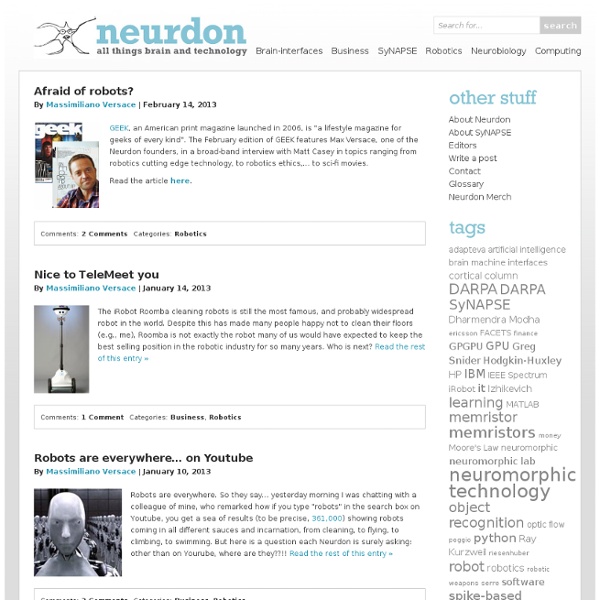



Modha's Cognitive Computing Fashionably Geek — Clothing and accessories for the well-dressed geek The human brain can create structures in up to 11 dimensions Neuroscientists have used a classic branch of maths in a totally new way to peer into the structure of our brains. What they've discovered is that the brain is full of multi-dimensional geometrical structures operating in as many as 11 dimensions. We're used to thinking of the world from a 3-D perspective, so this may sound a bit tricky, but the results of this new study could be the next major step in understanding the fabric of the human brain - the most complex structure we know of. This latest brain model was produced by a team of researchers from the Blue Brain Project, a Swiss research initiative devoted to building a supercomputer-powered reconstruction of the human brain. The team used algebraic topology, a branch of mathematics used to describe the properties of objects and spaces regardless of how they change shape. "We found a world that we had never imagined," says lead researcher, neuroscientist Henry Markram from the EPFL institute in Switzerland.
Neuroskeptic Geekologie - Gadgets, Gizmos, and Awesome Neural Nets Are Overparameterized · Gwern.net Neural nets are extremely ‘overparameterized’ in the sense that they have orders of magnitude more parameters than necessary to solve the problems they are trained on, as can be proven by the regular improvements in training smaller/faster but still performant networks but also in directly creating smaller neural nets with similar or identical performance on those problems by deleting parameters (sparsification)/reducing precision of the numeric encoding (compressing)/training a much smaller network from scratch using the original large network somehow (distillation); mysteriously, these smaller networks typically cannot be trained from scratch; performance gains can be obtained without the original data; models can be trained to imitate themselves in self-distillation; despite this indicating overfitting ought to be a major concern, they generalize well; and many of these smaller networks are in some sense already present in the original neural network.
The Daily Brain If I offered to sell you a liquid extract made from the velvety coating of deer antlers, claiming that it will catalyze muscle growth, slow aging, improve athletic performance and supercharge your libido – I’d expect you'd be a little skeptical. But what if I added that a huge percentage of professional athletes are using the stuff and paying top dollar, $100 or more an ounce, and swear up and down that just a few mouth sprays a day provides all benefits as advertised? Would you be willing to give it a try? Ever since former Baltimore Ravens star Ray Lewis admitted a few months ago that he used deer antler spray (though subsequently denied it), the market for the stuff has exploded. Some estimates say that close to half of all professional football and baseball players are using it and a hefty percentage of college players as well, to say nothing of the army of weightlifters and bodybuilders that have made the spray a daily part of their routines.
Hydrocephalus and Intelligence: The Hollow Men · Gwern.net Hydrocephalus is a damaging brain disorder where fluids compress the brain, sometimes drastically decreasing its volume. While often extremely harmful or life-threatening when untreated, some people with severe compression nevertheless are relatively normal, and in one case (Lorber) they have been claimed to have IQs as high as 126 with a brain volume 5% of normal brains. An argument recently summarized by ex-biologist SF author argues that intelligence of human brains may have little to do with brain size variables such as neuron count, relying on an example of , a medical condition: For decades now, I have been haunted by the grainy, black-and-white x-ray of a human skull. It is alive but empty, with a cavernous fluid-filled space where the brain should be. What scared me was the fact that this virtually brain-free patient had an IQ of 126. Big if true. These claims however run into a lot of objections: Extraordinary claims require extraordinary evidence. Fake data. Hawks on Lorber
Brain Waves Moravec's paradox Moravec's paradox is the discovery by artificial intelligence and robotics researchers that, contrary to traditional assumptions, high-level reasoning requires very little computation, but low-level sensorimotor skills require enormous computational resources. The principle was articulated by Hans Moravec, Rodney Brooks, Marvin Minsky and others in the 1980s. As Moravec writes, "it is comparatively easy to make computers exhibit adult level performance on intelligence tests or playing checkers, and difficult or impossible to give them the skills of a one-year-old when it comes to perception and mobility." Linguist and cognitive scientist Steven Pinker considers this the most significant discovery uncovered by AI researchers. The main lesson of thirty-five years of AI research is that the hard problems are easy and the easy problems are hard. Marvin Minsky emphasizes that the most difficult human skills to reverse engineer are those that are unconscious. As Moravec writes: See also[edit]
neurodudes The brainweb: Phase synchronization and large-scale integration | Nature Reviews Neuroscience 1Abeles, M. Local cortical circuits (Springer, Berlin, 1982). Google Scholar 2Palm, G. Cell assemblies as a guideline for brain research. Concepts Neurosci. 1, 133–147 ( 1990).